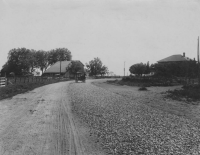








Macadam is a type of road construction pioneered by Scottish engineer John Loudon McAdam around 1820. The method simplified what had been considered state of the art at that point. Single-sized aggregate layers of small stones, with a coating of binder as a cementing agent, are mixed in an open-structured roadway.
John Loudon McAdam was born in Ayr, Scotland in 1756. In 1787 he became a trustee of the Ayrshire Turnpike in the Scottish Lowlands and during the next seven years this hobby became an obsession. He moved to Bristol, England in 1802 and became a Commissioner for Paving in 1806.On 15 January 1816 he was elected Surveyor-General of roads for the Turnpike Trust, and was now responsible for 149 miles of road.McAdam first put his ideas about road construction into major practice, the first 'macadamised' stretch of road being Marsh Road at Ashton Gate, Bristol.He also began to actively propagate his ideas in two booklets called Remarks (or Observations) on the Present System of Roadmaking, (which ran nine editions between 1816 and 1827) and A Practical Essay on the Scientific Repair and Preservation of Public Roads, published in 1819.
McAdam's method was simpler, yet more effective at protecting roadways: he discovered that massive foundations of rock upon rock were unnecessary, and asserted that native soil alone would support the road and traffic upon it, as long as it was covered by a road crust that would protect the soil underneath from water and wear.
Unlike Telford and other road builders of the time, McAdam laid his roads as level as possible. His 30-foot-wide (9.1 m) road required only a rise of 3 inches (7.6 cm) from the edges to the center. Cambering and elevation of the road above the water table enabled rain water to run off into ditches on either side.
Size of stones was central to the McAdam's road building theory. The lower 200-millimetre (7.9 in) road thickness was restricted to stones no larger than 75 millimetres (3.0 in). The upper 50-millimetre (2.0 in) layer of stones was limited to 20 millimetres (0.79 in) size and stones were checked by supervisors who carried scales. A workman could check the stone size himself by seeing if the stone would fit into his mouth. The importance of the 20 mm stone size was that the stones needed to be much smaller than the 100 mm width of the iron carriage tyres that travelled on the road.
McAdam believed that the "proper method" of breaking stones for utility and rapidity was accomplished by people sitting down and using small hammers, breaking the stones so that none of them was larger than six ounces in weight. He also wrote that the quality of the road would depend on how carefully the stones were spread on the surface over a sizeable space, one shovelful at a time.
McAdam directed that no substance that would absorb water and affect the road by frost should be incorporated into the road. Neither was anything to be laid on the clean stone to bind the road. The action of the road traffic would cause the broken stone to combine with its own angles, merging into a level, solid surface that would withstand weather or traffic.
Through his road-building experience McAdam had learned that a layer of broken angular stones would act as a solid mass and would not require the large stone layer previously used to build roads. By keeping the surface stones smaller than the tyre width, a good running surface could be created for traffic. The small surface stones also provided low stress on the road, so long as it could be kept reasonably dry.
The first macadam road built in the United States was constructed between Hagerstown and Boonsboro, Maryland and was named Boonsboro Turnpike Road. This was the last section of unimproved road between Baltimore on the Chesapeake Bay to Wheeling on the Ohio River. Stagecoaches traveling the Hagerstown to Boonsboro road in the winter took 5 to 7 hours to cover the 10-mile stretch. This road was completed in 1822, using McAdam's road techniques, except that the finished road was compacted with a cast-iron roller instead of relying on road traffic for compaction.The second American road built using McAdam principles was the Cumberland Road which was 73 miles long and was completed in 1830 after five years of work.
McAdam's renown is due to his effective and economical construction, which was a great improvement over the methods used by his generation. He emphasized that roads could be constructed for any kind of traffic, and he helped to alleviate the resentment travelers felt toward increasing traffic on the roads. His legacy lies in his advocacy of effective road maintenance and management. He advocated a central road authority and the trained professional official, who could be paid a salary that would keep him from corruption. This professional could give his entire time to his duties and be held responsible for his actions.